Unit6 Seasons 说课稿
- 格式:doc
- 大小:54.00 KB
- 文档页数:7
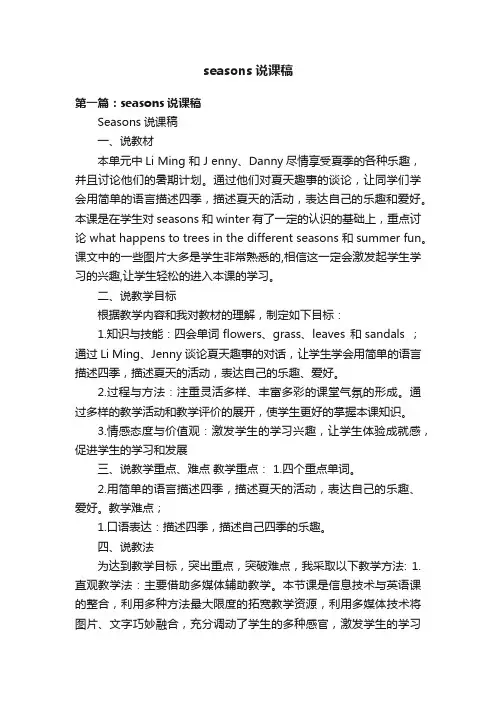
seasons说课稿第一篇:seasons说课稿Seasons说课稿一、说教材本单元中Li Ming 和 J enny、Danny尽情享受夏季的各种乐趣,并且讨论他们的暑期计划。
通过他们对夏天趣事的谈论,让同学们学会用简单的语言描述四季,描述夏天的活动,表达自己的乐趣和爱好。
本课是在学生对seasons和winter有了一定的认识的基础上,重点讨论 what happens to trees in the different seasons 和summer fun。
课文中的一些图片大多是学生非常熟悉的,相信这一定会激发起学生学习的兴趣,让学生轻松的进入本课的学习。
二、说教学目标根据教学内容和我对教材的理解,制定如下目标:1.知识与技能:四会单词flowers、grass、leaves 和sandals ;通过Li Ming、Jenny谈论夏天趣事的对话,让学生学会用简单的语言描述四季,描述夏天的活动,表达自己的乐趣、爱好。
2.过程与方法:注重灵活多样、丰富多彩的课堂气氛的形成。
通过多样的教学活动和教学评价的展开,使学生更好的掌握本课知识。
3.情感态度与价值观:激发学生的学习兴趣,让学生体验成就感,促进学生的学习和发展三、说教学重点、难点教学重点: 1.四个重点单词。
2.用简单的语言描述四季,描述夏天的活动,表达自己的乐趣、爱好。
教学难点;1.口语表达:描述四季,描述自己四季的乐趣。
四、说教法为达到教学目标,突出重点,突破难点,我采取以下教学方法: 1.直观教学法:主要借助多媒体辅助教学。
本节课是信息技术与英语课的整合,利用多种方法最大限度的拓宽教学资源,利用多媒体技术将图片、文字巧妙融合,充分调动了学生的多种感官,激发学生的学习兴趣,创设有利于激发和支持学生想象的情境,给学生以乐趣,更给学生以启迪,为学生创设了自主学习情境,提高了教学效率。
2.口语表达法:利用多种方法培养和提高学生的口语表达能力,如问答法、讨论法、对话法等多种形式给学生充分的进行口语表达的机会,让学生敢说、会说,并注意及时给与评价与鼓励。
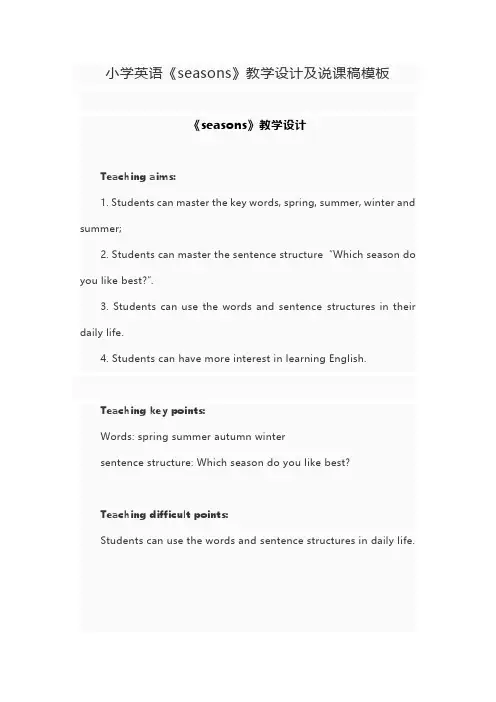
小学英语《seasons》教学设计及说课稿模板《seasons》教学设计Teaching aims:1. Students can master the key words, spring, summer, winter and summer;2. Students can master the sentence structure ”Which season do you like best?”.3. Students can use the words and sentence structures in their daily life.4. Students can have more interest in learning English.Teaching key points:Words: spring summer autumn wintersentence structure: Which season do you like best?Teaching difficult points:Students can use the words and sentence structures in daily life.Step1 Warming up1.greet with the students.2. play and enjoy the "Four seasons" song and ask students what they hear and then lead in our topic "season".Step 2 Presentation and practice1.the learning of the wordsDraw the picture of "spring summer autumn winter”on the blackboard to help students understand the meaning of the words.2.the learning of the sentence structureShow the videos of the four seasons and tell students my favorite season is summer and I like ice cream and then ask “which season do you like best”? to present the sentence structure.3.the practice of the sentence structureWork in pairs to ask and answer.4.Understanding the dialogue1)show pictures of Mr. Jones, Mike and Wuyifan and ask students to guess what they are talking about and then listen to the tape for the first time to check the answer.2)listen to the tape for the second time and answer the following questions:What's the music?Which season does Mike like best and why?Which season does Wuyifan like best and why?3) Listen to the tape for the third time and read after it and ask students to pay attention to their prounciation and innonation.5.Practice the dialogueStep 3 ProductionFour students in a group and ask students to do a survey using the sentence structure about what season their group members like and why. Then ask some representatives to report their survey.Blackboard Design《seasons》说课稿一、说教材本单元主要围绕“季节及气候”这个话题开展各项活动,所涉及的日常交际项目有介绍,询问,说原因等,其中以“询问天气”及其应答为重点内容。
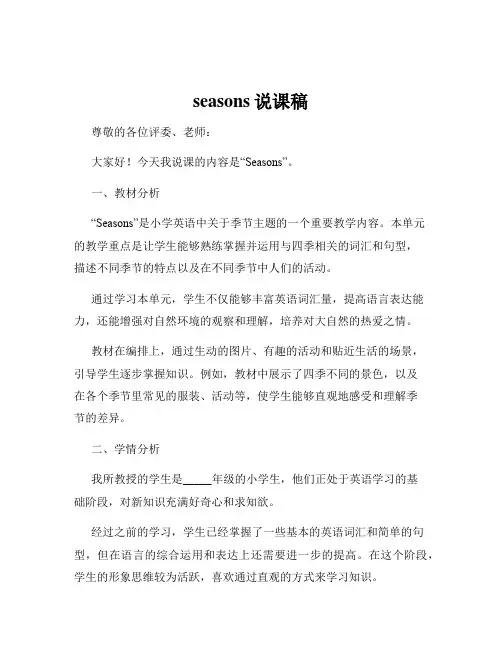
seasons说课稿尊敬的各位评委、老师:大家好!今天我说课的内容是“Seasons”。
一、教材分析“Seasons”是小学英语中关于季节主题的一个重要教学内容。
本单元的教学重点是让学生能够熟练掌握并运用与四季相关的词汇和句型,描述不同季节的特点以及在不同季节中人们的活动。
通过学习本单元,学生不仅能够丰富英语词汇量,提高语言表达能力,还能增强对自然环境的观察和理解,培养对大自然的热爱之情。
教材在编排上,通过生动的图片、有趣的活动和贴近生活的场景,引导学生逐步掌握知识。
例如,教材中展示了四季不同的景色,以及在各个季节里常见的服装、活动等,使学生能够直观地感受和理解季节的差异。
二、学情分析我所教授的学生是_____年级的小学生,他们正处于英语学习的基础阶段,对新知识充满好奇心和求知欲。
经过之前的学习,学生已经掌握了一些基本的英语词汇和简单的句型,但在语言的综合运用和表达上还需要进一步的提高。
在这个阶段,学生的形象思维较为活跃,喜欢通过直观的方式来学习知识。
1、知识目标学生能够听、说、认读单词:spring, summer, autumn, winter 。
能够理解并运用句型:It's in 描述不同季节的气候特点。
2、能力目标能够用英语简单描述四季的特点和自己喜欢的季节。
培养学生的观察能力和语言表达能力。
3、情感目标让学生感受四季的美好,激发对大自然的热爱之情。
培养学生积极参与课堂活动,增强学习英语的自信心。
四、教学重难点1、教学重点掌握四个季节的单词:spring, summer, autumn, winter 。
运用句型“It's in”描述季节的气候特征。
2、教学难点单词 autumn 的发音。
能够灵活运用所学知识,用英语描述不同季节的特点和自己的感受。
为了实现教学目标,突破教学重难点,我将采用以下教学方法:1、情景教学法通过创设生动的情景,让学生在真实的语境中学习和运用英语。
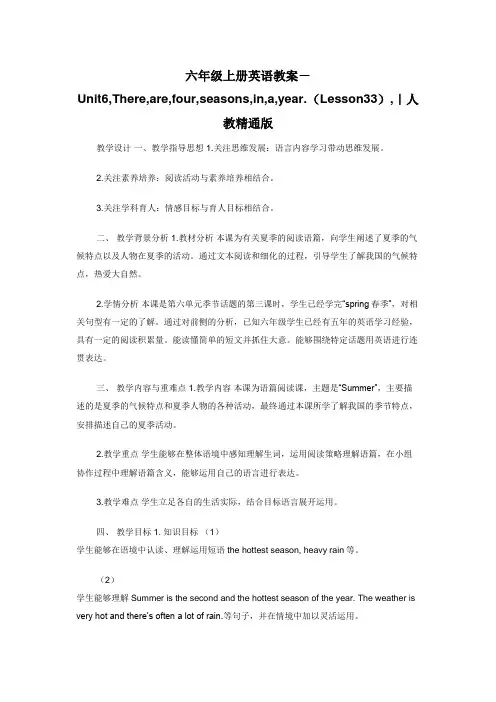
六年级上册英语教案-Unit6,There,are,four,seasons,in,a,year.(Lesson33),|人教精通版教学设计一、教学指导思想 1.关注思维发展:语言内容学习带动思维发展。
2.关注素养培养:阅读活动与素养培养相结合。
3.关注学科育人:情感目标与育人目标相结合。
二、教学背景分析 1.教材分析本课为有关夏季的阅读语篇,向学生阐述了夏季的气候特点以及人物在夏季的活动。
通过文本阅读和细化的过程,引导学生了解我国的气候特点,热爱大自然。
2.学情分析本课是第六单元季节话题的第三课时,学生已经学完“spring春季”,对相关句型有一定的了解。
通过对前侧的分析,已知六年级学生已经有五年的英语学习经验,具有一定的阅读积累量。
能读懂简单的短文并抓住大意。
能够围绕特定话题用英语进行连贯表达。
三、教学内容与重难点 1.教学内容本课为语篇阅读课,主题是“Summer”,主要描述的是夏季的气候特点和夏季人物的各种活动,最终通过本课所学了解我国的季节特点,安排描述自己的夏季活动。
2.教学重点学生能够在整体语境中感知理解生词,运用阅读策略理解语篇,在小组协作过程中理解语篇含义,能够运用自己的语言进行表达。
3.教学难点学生立足各自的生活实际,结合目标语言展开运用。
四、教学目标 1. 知识目标(1)学生能够在语境中认读、理解运用短语the hottest season, heavy rain等。
(2)学生能够理解Summer is the second and the hottest season of the year. The weather is very hot and there’s often a lot of rain.等句子,并在情境中加以灵活运用。
(3)通过精读文本,学生能够联系实际生活,描述夏季的季节特点和自己的夏季活动。
2. 技能目标(1)学生继续学习运用快速阅读获取关键信息的基本阅读策略。
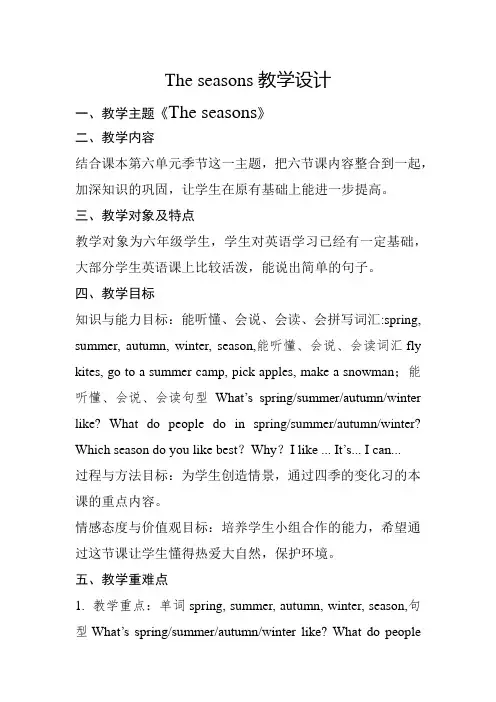
The seasons教学设计一、教学主题《The seasons》二、教学内容结合课本第六单元季节这一主题,把六节课内容整合到一起,加深知识的巩固,让学生在原有基础上能进一步提高。
三、教学对象及特点教学对象为六年级学生,学生对英语学习已经有一定基础,大部分学生英语课上比较活泼,能说出简单的句子。
四、教学目标知识与能力目标:能听懂、会说、会读、会拼写词汇:spring, summer, autumn, winter, season,能听懂、会说、会读词汇fly kites, go to a summer camp, pick apples, make a snowman;能听懂、会说、会读句型What’s spring/summer/autumn/winter like? What do people do in spring/summer/autumn/winter? Which season do you like best?Why?I like ... It’s... I can...过程与方法目标:为学生创造情景,通过四季的变化习的本课的重点内容。
情感态度与价值观目标:培养学生小组合作的能力,希望通过这节课让学生懂得热爱大自然,保护环境。
五、教学重难点1.教学重点:单词spring, summer, autumn, winter, season,句型W hat’s spring/summer/autumn/winter like? What do peopledo in spring/summer/autumn/winter?2.教学难点:Introduce seasons, Which season do you like best?Why?I like ...I t’s... I c an...六、教学方法情景教学、小组合作七、教学准备录音、卡片、PPT八、教学过程Step1:lead-inT:Let’s listen a song. What’s the song about?Ss: I t’s about the seasons.T:Yes. Today we’ll learn about the seasons.Now let’s learn to seasons.Step2:presentation1.Teach the new words.(show the pictures about seasons)Four seasons: spring, summer, autumn, winterAsk the questions: How many seasons are there in the year? There are four seasons in a year.Learn words and practice .T:Look at the picture. What season is it?It’s spring. Do you like spring?Ss: Yes ,I do.T:What can you do in spring?Ss: We can fly kites, have a picnic, plant trees…T:I like spring ,too. I t’s warm. We can see green trees and green grass everywhere. I can fly kites with my friends. I can go on a trip with my family. I like fly kites, too.Now let talk about the other seasons.(Summer autumn winter)use the same way to introduce.Step3:prastice1.Make conversation with your partner.2.Call some groups to show it.Use this sentences: Which season do you like best?Why?I like ...I t’s...I can...2.You all did good a job. I hope you can love the nature、county、family and yourself.Step4: homework:1.Remember the new words;2.Practise the sentences;3.Introduce seasons to your friends or family.Step5:balckboard:Seasonsspring summer autumn winterwarm hot cool coldWhich seasons do you like best? Why?I like ... I t’s...I can...九、所选技术及技术使用目的使用了插入技术,课件中插入了季节里代表性的图片及单词音频。
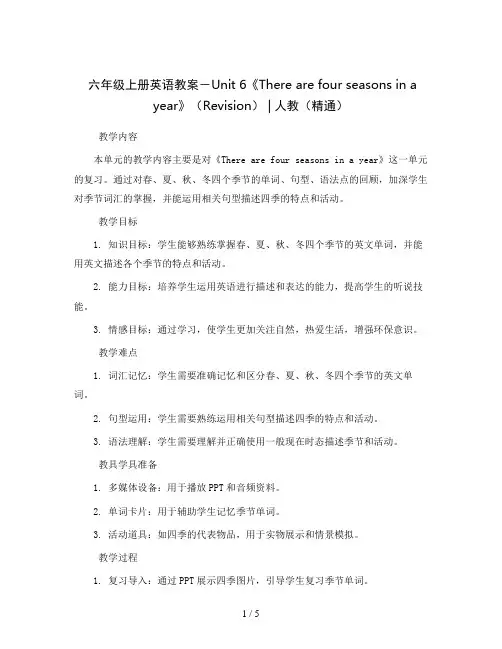
六年级上册英语教案-Unit 6《There are four seasons in a year》(Revision) | 人教(精通)教学内容本单元的教学内容主要是对《There are four seasons in a year》这一单元的复习。
通过对春、夏、秋、冬四个季节的单词、句型、语法点的回顾,加深学生对季节词汇的掌握,并能运用相关句型描述四季的特点和活动。
教学目标1. 知识目标:学生能够熟练掌握春、夏、秋、冬四个季节的英文单词,并能用英文描述各个季节的特点和活动。
2. 能力目标:培养学生运用英语进行描述和表达的能力,提高学生的听说技能。
3. 情感目标:通过学习,使学生更加关注自然,热爱生活,增强环保意识。
教学难点1. 词汇记忆:学生需要准确记忆和区分春、夏、秋、冬四个季节的英文单词。
2. 句型运用:学生需要熟练运用相关句型描述四季的特点和活动。
3. 语法理解:学生需要理解并正确使用一般现在时态描述季节和活动。
教具学具准备1. 多媒体设备:用于播放PPT和音频资料。
2. 单词卡片:用于辅助学生记忆季节单词。
3. 活动道具:如四季的代表物品,用于实物展示和情景模拟。
教学过程1. 复习导入:通过PPT展示四季图片,引导学生复习季节单词。
2. 句型练习:利用课本中的对话,进行角色扮演,练习描述季节的句型。
3. 语法讲解:结合课本内容,讲解一般现在时态的用法。
4. 小组活动:学生分组,每组选择一个季节进行描述,准备进行课堂展示。
5. 课堂展示:每组学生上台展示,其他学生进行评价。
6. 总结反馈:教师对学生的表现进行点评,总结学习要点。
板书设计板书将包括以下内容:- 四季的英文单词- 描述季节的常用句型- 一般现在时态的语法点作业设计1. 单词默写:学生需要默写四季的英文单词。
2. 句子造句:用所学句型造句,描述自己最喜欢的季节。
3. 短文写作:写一篇关于自己最喜欢的季节的短文。
课后反思通过本节课的教学,我期望学生能够熟练掌握四季的英文单词,并能够运用所学句型和时态描述四季的特点和活动。
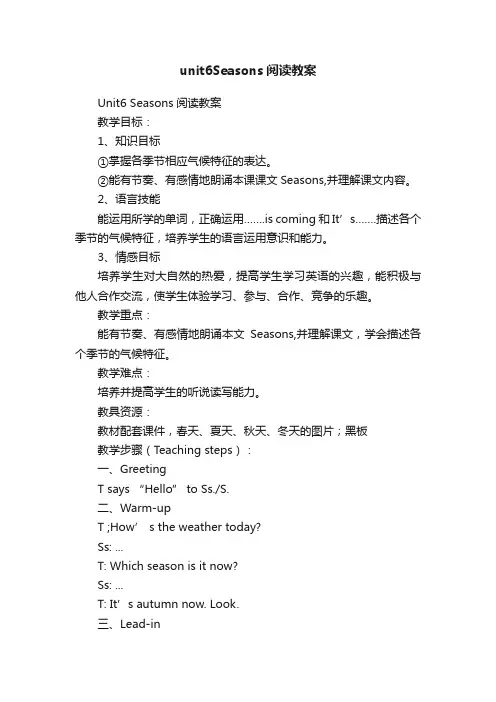
unit6Seasons阅读教案Unit6 Seasons阅读教案教学目标:1、知识目标①掌握各季节相应气候特征的表达。
②能有节奏、有感情地朗诵本课课文Seasons,并理解课文内容。
2、语言技能能运用所学的单词,正确运用…….is coming 和It’s…….描述各个季节的气候特征,培养学生的语言运用意识和能力。
3、情感目标培养学生对大自然的热爱,提高学生学习英语的兴趣,能积极与他人合作交流,使学生体验学习、参与、合作、竞争的乐趣。
教学重点:能有节奏、有感情地朗诵本文Seasons,并理解课文,学会描述各个季节的气候特征。
教学难点:培养并提高学生的听说读写能力。
教具资源:教材配套课件,春天、夏天、秋天、冬天的图片;黑板教学步骤(T eaching steps):一、GreetingT says “Hello” to Ss./S.二、Warm-upT ;How’ s the weather today?Ss: ...T: Which season is it now?Ss: ...T: It’s autumn now. Look.三、Lead-inHow many seasons are there in a year? What are they?T: There are four seasons in a year. They are spring, summer, autumn, and winter.Nature is a magician. Summer is hot. Winter is cold. Now, let’s enjoy the four seasons.And find out which one is spring. Which one is summer? Which one is autumn?Which one is winter?(设计意图:让学生完整感知所学内容。
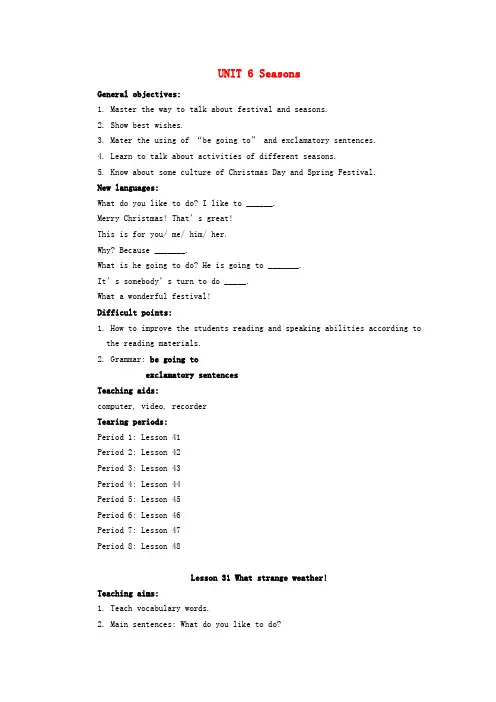
UNIT 6 SeasonsGeneral objectives:1. Master the way to talk about festival and seasons.2. Show best wishes.3. Mater the using of “be going to” and exclamatory sentences.4. Learn to talk about activities of different seasons.5. Know about some culture of Christmas Day and Spring Festival.New languages:What do you like to do? I like to ______.Merry Christmas! That’s great!This is for you/ me/ him/ her.Why? Because _______.What is he going to do? He is going to _______.It’s somebody’s turn to do _____.What a wonderful festival!Difficult points:1. How to improve the students reading and speaking abilities according tothe reading materials.2. Grammar: be going toexclamatory sentencesTeaching aids:computer, video, recorderTearing periods:Period 1: Lesson 41Period 2: Lesson 42Period 3: Lesson 43Period 4: Lesson 44Period 5: Lesson 45Period 6: Lesson 46Period 7: Lesson 47Period 8: Lesson 48Lesson 31 What strange weather!Teaching aims:1. Teach vocabulary words.2. Main sentences: What do you like to do?What a cold, snowy day!3. Master exclamatory sentences.4. Train the speaking and listening abilities.5. Learn to talk about the winter.Lesson structure:Class opening:1. Greeting.2. Duty report.3. Sing “the month song”.4. Play “what day is it?” to review the seasons.Key concepts:Put on _____ (winter, jackets, scarf, mittens, hat…)What a cold, snowy day!skate, ski, ice, snowLearn, teach.Step 1. Presentation1. Teacher: (Show a window, some snow outside it with a computer. Pretendto be very cold.)What’s the weather like today?Students: it’s cold and snowy.Teacher: Yes. Look out of the window. It’s snowing. It’s winter.What do I wear in winter? I want my mittens. Now I am puttingon my mittens. What a cold snowy day!2. Demonstrate ski and skate with pictures that show Danny skiing andskating.Teacher: Look! What is Danny doing?Students: Danny is skating.Teacher: What is Danny doing?Students: Danny is skiing.Teacher: Can you ski? (To student 1)Student 1: No, I can’t.Teacher: Can you skate? (To student 2)Student 2: Yes, I can.Step 2. Practice1. Drill1) Teacher: What a cold day!Students: What a cold day!Teacher: What a cold, snowy day!Students: What a cold, snowy day!Teacher: Put on the winter jackets!Students: Put on the winter jackets!Teacher: Mittens.Students: Put on the mittens!Teacher: Scarf.Students: Put on the scarf!2) Student A: (To B) Can you ski?Student B: No, I can’t. (To C) Can you skate?Student C: yes, I can. (To D) Can you swim?Student D: yes, I can. (To E) Can you jump?3) Teacher: I like to skate.Students: I like to skate.Teacher: I like to skate on the ice.Teacher: Ski.Students: I like to ski.Teacher: I like to ski Students: I like to ski.Students: I like to ski Students: I like to ski.2. Listen to the dialogue with the following questions:What does Li Ming like to do?What does Li Ming want to learn?After listening answer the questions together. Discuss the dialogue again and make sure they can understand the meaning of the text.3. Read aloud.4. Ask for volunteers to read the dialogue.5. Divide the class into small groups. Ask each group to male up adialogue about a cold, snowy winter day.6. Talk about exclamatory sentence. Use this sentence as an example:What a cold, snowy day!The structure of the exclamatory sentences:What + a (an) + adj. + n. + (sub. + v.)You can give more examples then ask students to make some sentences. Step 3. Conclusion1. Learn and master the vocabulary words.2. Master the main sentences: What do you like to do?What a cold, snowy day!Steps 4. Homework1. Finish off the activity book.2. Practice the dialogue in this lesson.3. Preview next lesson.Lesson 32 I can’t wait for winter!Teaching aims:1. Teach vocabulary words.2. Main languages:First, we make a big ball of snow.Then, we make another snowball, and put it on top of the other two.Look out! D on’t throw snowball at me.3. Practise the speaking ability.Lesson resources:Class opening:1. Greeting.2. Duty report3. Sing “the month song”4. Play “What day is it?” to review the week, months and ordinal numbers.5. Play the variation of “dress up” to review the seasons.Key concepts:Make a snowman/ snowball, look out, and throw.Step 1. PresentationShow a picture about a snowman and some children throwing snowballs with the computer.Teacher: What’s this?Students: I t’s a snowman.Teacher: What are the children doing?Students: They are throwing snowballs.Teacher: Do you play with snow in winter?Students: Yes. / No.Step 2. Practice1. DrillTeacher: Snowballs.Students: Snowballs.Teacher: Make snowballs.Students: Make snowballs.Teacher: Make snowballs and throw snowballs.Students: Make snowballs and throw snowball.Teacher: They are making snowballs and throwing them.Students: They are making snowballs and throwing them.2. Books closed! Ask some questions: what are the children doing? Arethe having fun? Listen to the audiotape.3. Check the answers4. Listen to the dialogue with the following questions:What happens to Jenny?What do Jenny and Li Ming make?After listening answer the questions together. Discuss the dialogueagain and make sure they can understand the meaning of the text. Dealwith the language points at the same time. 5. Practice in smallgroups.6. Present. Ask some volunteers to act the dialogue.7. Discuss:What are Jenny and Li Ming making? What do they do first? How manysnowballs does the snowman have? Does the snowman have eyes/ ears/arms/ feet/ a mouth/ a nose? Li Ming wants to go inside. Why?8. Make up a new dialogue. Divide the class into small groups. Ask eachgroup to make up a dialogue about playing with snow.Step 3. ConclusionMaster the words of this lesson and some main languages.Step 4. Homework1. Finish off the activity book.2. Practice the dialogue in this lesson.3. Preview the next lesson.Lesson 33 Kim’s Favourite SeasonI,Teaching important points1,Master the new words and phrases in this lesson. Such asa kind of, be filled with, pick up, in front of , in the frontof,give sb. sth. = give sth. to sb.2,Talking about the different seasons.II,Teaching difficult points1,The differences bet ween in front of …and in the front of…2,The usages of pick up,be full of and be filled with.3,How to write a report about different seasons correctly.III,Teaching timeOne periodIV. Teaching stepslead-in:Hi, everyone! There are four seasons in a year, but what’s your favourite season? (spring, summer, autumn or winter). Do you know Kim’s favourite season ? (No).OK, Let’s learn about Kim’s favourite season.(showing the title of Lesson 44 by PPT).Step 1. Showing the aims ( by PPT).1,Master the new words and phrases in this lesson.2, Revise “be going to”3,Learn about some activities related to the seasons.4,After learning this lesson, students can write a report about different seasons.Step 2. Self-learning and discuss in groups1, Read the text and find out the words that they unknown, and discuss them, then I teach them to read the words.2, Read the text and answer the following questions, first, they answer them by themselves. Then check the keys and discuss them in groups.1) ,Who is talking at the front of the class?2) . What season is Kim talking about?3).How is the temperature is in this season?4).What does Kim often wear?5). How many bags do they pick the apples?3, Write a short story about your favourite season. What activities do you like to do? What clothes do you like to wear? What food do you usually eat? Do NOT write what the season is. Can your classmates guess?! 4,Talk about the following language points. ( I can give them some cues by ppt )Pick, full, clap, kind, fillBe going to, in front of/in the front of, give Sth. to Sb.Step 3, Teaching and explaining1,She stands in front of the class and holds a very big, black bag? in front of 指在某一范围以外的前面,而in the front of 指在某一范围以内的前面。

冀教版英语七下Unit 6《Seasons》单元说课稿一. 教材分析冀教版英语七下Unit 6《Seasons》是一个关于四季的单元。
本单元主要让学生掌握四季的名称、特点以及与季节相关的天气、衣物、活动等词汇和表达方式。
通过本单元的学习,学生能够用英语简单描述四季的特点和变化,提高他们的语言运用能力。
二. 学情分析七年级的学生已经掌握了一些基本的英语语法和词汇,具备一定的听说读写能力。
但是,他们对季节的认识可能还不够全面,对季节相关的词汇和表达方式也相对陌生。
因此,在教学过程中,需要关注学生的个体差异,合理安排教学内容,激发学生的学习兴趣,帮助他们更好地理解和运用本单元的知识。
三. 说教学目标1.知识目标:学生能够掌握四季的名称、特点以及与季节相关的天气、衣物、活动等词汇和表达方式。
2.能力目标:学生能够用英语简单描述四季的特点和变化,提高他们的语言运用能力。
3.情感目标:通过本单元的学习,学生能够培养对大自然的热爱和珍惜,增强环保意识。
四. 说教学重难点1.重点:四季的名称、特点以及与季节相关的天气、衣物、活动等词汇和表达方式。
2.难点:用英语描述四季的特点和变化,以及如何正确运用本单元的知识进行实际交流。
五. 说教学方法与手段1.交际法:通过小组讨论、角色扮演等形式,让学生在实际语境中运用本单元的知识,提高他们的语言实践能力。
2.情境教学法:利用图片、视频等资源,创设生动直观的教学情境,帮助学生更好地理解和掌握知识。
3.任务型教学法:设计各种任务,让学生在完成任务的过程中,运用本单元的知识,提高他们的实际运用能力。
六. 说教学过程1.导入:通过展示四季变化的图片,引导学生谈论他们对四季的认识和感受,激发学生的学习兴趣。
2.新课呈现:介绍四季的名称和特点,呈现与季节相关的词汇和表达方式,让学生进行听力练习。
3.课堂活动:分组进行角色扮演,让学生模拟四季的场景,运用本单元的知识进行实际交流。
4.巩固练习:设计各种练习题,让学生进行听力、口语和笔头的训练,巩固所学知识。
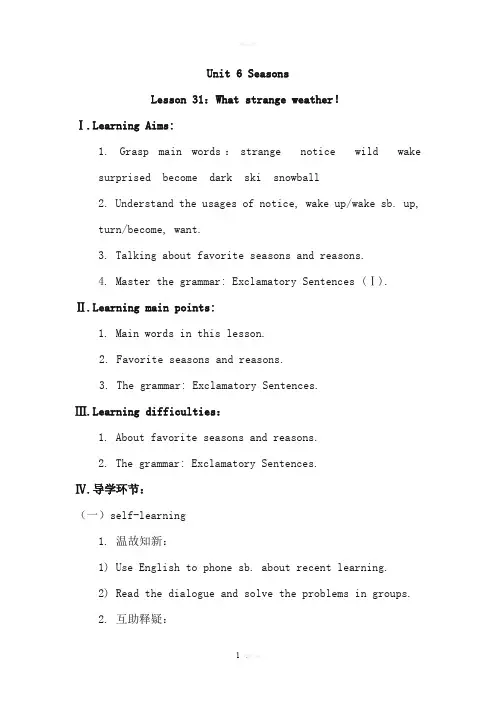
Unit 6 SeasonsLesson 31:What strange weather!Ⅰ.Learning Aims:1. Grasp main words:strange notice wild wakesurprised become dark ski snowball2. Understand the usages of notice, wake up/wake sb. up,turn/become, want.3. Talking about favorite seasons and reasons.4. Master the grammar: Exclamatory Sentences (Ⅰ).Ⅱ.Learning main points:1. Main words in this lesson.2. Favorite seasons and reasons.3. The grammar: Exclamatory Sentences.Ⅲ.Learning difficulties:1. About favorite seasons and reasons.2. The grammar: Exclamatory Sentences.Ⅳ.导学环节:(一)self-learning1. 温故知新:1) Use English to phone sb. about recent learning.2) Read the dialogue and solve the problems in groups.2. 互助释疑:the noun of strange-----stranger e.g. He is stranger.notice sb. do/doing sth. (经常做与正在做)wake up(醒来),wake sb. up(叫醒或唤醒某人)become/turn + adj.want sb. to do sth.什么叫感叹句?感叹句是表示喜怒哀乐等强烈感情的句子。
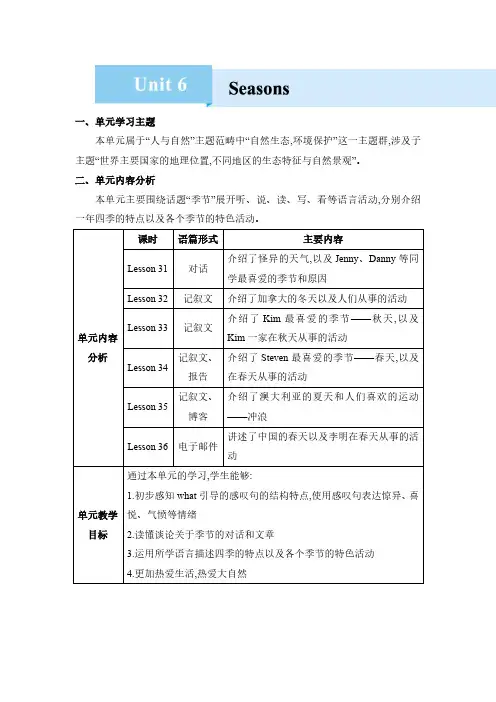
一、单元学习主题
本单元属于“人与自然”主题范畴中“自然生态,环境保护”这一主题群,涉及子主题“世界主要国家的地理位置,不同地区的生态特征与自然景观”。
二、单元内容分析
本单元主要围绕话题“季节”展开听、说、读、写、看等语言活动,分别介绍一年四季的特点以及各个季节的特色活动。
单元内容分析
课时语篇形式主要内容
Lesson31对话
介绍了怪异的天气,以及Jenny、Danny等同
学最喜爱的季节和原因
Lesson32记叙文介绍了加拿大的冬天以及人们从事的活动Lesson33记叙文
介绍了Kim最喜爱的季节——秋天,以及
Kim一家在秋天从事的活动
Lesson34
记叙文、
报告
介绍了Steven最喜爱的季节——春天,以及
在春天从事的活动
Lesson35
记叙文、
博客
介绍了澳大利亚的夏天和人们喜欢的运动
——冲浪
Lesson36电子邮件
讲述了中国的春天以及李明在春天从事的活
动
单元教学目标通过本单元的学习,学生能够:
1.初步感知what引导的感叹句的结构特点,使用感叹句表达惊异、喜悦、气愤等情绪
2.读懂谈论关于季节的对话和文章
3.运用所学语言描述四季的特点以及各个季节的特色活动
4.更加热爱生活,热爱大自然。
说课稿各位领导,老师大家好,我说课的内容是UNIT 6.WEATHER SEASONS.下面我主要从教材分析,教学目标,教学重难点,教法,学法,教学过程几个方面作具体阐述:一.教材分析本节课主要围绕“季节及气候”这个话题开展各项活动,所涉及的日常交际项目有介绍,询问,说原因等,其中以“询问天气”及其应答,“询问最喜欢的季节”和“越来越”结构为重点内容,同时学习一些常用的与气象相关的一些词汇,主要是让学生掌握如何用英语介绍四个季度的气候特点,培养学生运用所学功能用语谈论天气和季节的能力,侧重培养学生的口头表达能力,二.教学目标(一)知识目标1、词汇:weather, season, spring, summer, autumn, winter, rain, snow, warm, cool2、句型:2、句型:What's the weather like ?what’s your favorite season?(二)功能目标让学生了解气候的变化,不同季节有不同的气候,不同时间有不同的气候,并能用英语来询问气候、表达气候。
(三)情感目标通过对本课的学习,使同学们感受到大自然的美丽风光,进而培养学生热爱大自然情感。
增强同学们热爱环境、保护环境的意识。
三.教学重难点:重点:1.让同学们掌握一些重要词组(turn green. Be good for Start to 等)2.让同学们掌握几个重点句型:(1.what.the weatherlike ….2.what’s your favorite season in a year 3 I can …..4.越来越型等)难点:培养学生通过快速阅读准确获取信息的能力,培养学生运用所学功能用语谈论天气和季节的口头表达能力。
四.教法:本课侧重培养学生运用所学功能用语谈论天气和季节的口头表达能力。
利用图片等多媒体手段创设情景,培养学生直接用英语理解和思维的能力,在具体教学过程中始终将学生置于主体地位,使他们不停地动脑子将零散的语言组织到一起,并积极地表达出来,达到培养和强化学生的语言实践能力,我所依据的教学方法有;1.任务型教学法:这是新课标所倡导的新的教学理念,引导学生在完成任务的过程中“用中学,学中用”。
人教版英语六年级上U nit6There are four seasons in a year. lesson31编制人:使用人:一、教学目标:1.能够简单描绘一年之中春季的特点。
2.能够简单描绘季节和气候3.培养热爱大自然的良好品质。
教学重点:描述一年有几个季节的句型以及比较级的用法。
导学指导:小组讨论运用课文中的句型对四季特点进行简单的描述。
教学方法:合作法,自主学习法学情分析:学生对前一单元的月份学习较好,这单元的关于季节的词汇他们掌握的不是特别到位,对于课文他们有很强烈的好奇心,因此要让他们带着好奇去学习。
课时安排:2课时二、课前准备1.准备本课的教学挂图、录音磁带和投影片。
2.准备有关春天的几张照片。
三、教学步骤1.热身/ 复习(Warming-up / Revision)1)放歌曲The Four Seasons,师生一起欣赏。
2)师生共同学唱歌曲Spring,不要求一次学会。
3)值日生英语汇报。
(设计意图:让学生在轻松、温馨的氛围中感知各种不同天气的变化也进一步调节课堂学习气氛,激发学生学习兴趣。
2.新课导入(Presentation)1)教师首先引出本课的话题:一、自主学习:1.小组内学习短语2.教师适时点拨,熟读课文并记忆重点句型。
二、合作探究1、各小组找出课文中出现的春季人们的活动,并派同学去黑板上书写。
2、总结一年四季是在一年中的第几个季节(设计意图:通过让学生相互讨论,培养学生合作意识,拓展学生的知识面,培养学生想象力和表达能力。
进一步让学生谈论不同季节人们喜爱从事的活动,让他们感受生活的美好。
)3.趣味操练(Practice)1)让学生合上书看挂图,教师播放录音,让学生听录音模仿。
2)让学生两人一组,借助挂图,以pair work的形式练习课本第58页下面的小对话。
3)让学生分成5人小组,自由联想有关SPRING的事物。
包括学过的英语单词、汉语词语、气候知识、孩子们自己过去的有关春天的经历等。
小学英语《seasons》教学设计及说课稿模板《seasons》教学设计Teaching aims:1. Students can master the key words, spring, summer, winter and summer;2. Students can master the sentence structure ”Which season do you like best?”.3. Students can use the words and sentence structures in their daily life.4. Students can have more interest in learning English.Teaching key points:Words: spring summer autumn wintersentence structure: Which season do you like best?Teaching difficult points:Students can use the words and sentence structures in daily life.Step1 Warming up1.greet with the students.2. play and enjoy the "Four seasons" song and ask students what they hear and then lead in our topic "season".Step 2 Presentation and practice1.the learning of the wordsDraw the picture of "spring summer autumn winter”on the blackboard to help students understand the meaning of the words.2.the learning of the sentence structureShow the videos of the four seasons and tell students my favorite season is summer and I like ice cream and then ask “which season do you like best”? to present the sentence structure.3.the practice of the sentence structureWork in pairs to ask and answer.4.Understanding the dialogue1)show pictures of Mr. Jones, Mike and Wuyifan and ask students to guess what they are talking about and then listen to the tape for the first time to check the answer.2)listen to the tape for the second time and answer the following questions:What's the music?Which season does Mike like best and why?Which season does Wuyifan like best and why?3) Listen to the tape for the third time and read after it and ask students to pay attention to their prounciation and innonation.5.Practice the dialogueStep 3 ProductionFour students in a group and ask students to do a survey using the sentence structure about what season their group members like and why. Then ask some representatives to report their survey.Blackboard Design《seasons》说课稿一、说教材本单元主要围绕“季节及气候”这个话题开展各项活动,所涉及的日常交际项目有介绍,询问,说原因等,其中以“询问天气”及其应答为重点内容。
Unit6 Revision 教学设计一、教学内容与分析1. Fun story小猫Mimi向小猴子Micky推荐一本书,但贪玩的Micky将书搁置了一年还没有阅读,以趣味故事的形式把本单元的教学内容融合在一起,综合再现,提供机会让学生在真实的语境中复习巩固所学的英语。
2. Let’s listen and number听力练习,检测学生对本单元重点语言的理解和掌握。
3. Language Focus本部分分类总结梳理本单元要求掌握的核心词语和句式,方便教师设计复习练习活动,检测学生对重点语言内容的掌握情况。
4. Fun Facts本部分是一篇关于复活节的语段,让学生通过阅读了解一些有关西方国家的儿童在复活节的活动,逐步提高阅读技能。
二、课前准备1. 准备本课的教学挂图、视频和音频。
2. 准备Micky和Mimi的头饰。
3. 准备教学课件PPT。
三、教学步骤与建议1. 热身/复习(Warm-up / Revision)1) 教师带领学生演唱Four Seasons,复习有关四季的语言。
2) 教师展示教学挂图,让学生猜每幅图发生的时间背景,每次猜一幅图。
提醒学生根据图画所表现的景物来猜。
如果有学生猜对,教师应及时表扬,然后让学生说出理由。
2. 新课呈现(Presentation)1) 展示复习课教学挂图,让学生分成小组,猜猜Micky和Mimi在干什么,发生了什么有趣的事情。
小组内讨论后找一个代表到前面来指着挂图给大家讲故事。
2) 教师根据课本内容简要讲故事给学生听。
边指图边讲,留意学生的反应,速度适当放慢,必要的地方可以重复。
3) 播放录音,让学生看图听音,跟读内容。
4) 教师组织学生通过跟读、分角色读等方式模仿对话内容,最后进行对话表演。
3. 趣味操练(Practise)1) 根据录音内容完成Listen and number部分的练习,检测自己的学习情况。
2) Bingo Game:教师设计教学课件,为学生提供本课单词所涉及的字母,让学生在限定时间内组词、组句,看谁说得多。
六年级英语theseasons说课教案(5篇)第一篇:六年级英语the seasons说课教案牛津英语6A Unit 5 The seasons说课稿一.教材分析:本单元的主要话题是“季节及气候”。
学习一些常用的与气象相关的一些词汇以及如何询问天气及应答。
1.知识目标:1)能听懂、会说、会说和会写spring,summer,autumn,winter。
2)能听懂、会说和会读单词warm, cool ,sunny, cloudy, rainy, windy, foggy, snowy.3)能用句型Which season do you like best? What’s the weather like?进行问答。
教学过程: 2.能力目标:培养学生的语言交际能力。
3.情感目标:1)通过对天气的描述,培养热爱大自然的感情。
2)通过各种活动培养对英语学习的兴趣。
4.教学重点、难点:正确区分各个季节的词汇,了解各个季节的气候特征。
二、教学策略新课程强调从学生的学习兴趣、生活经验和认识水平出发,倡导体验、实践、参与、合作与交流的学习方式和任务型的教学途径达到发展学生对语言的综合运用能力。
小学生好奇心强,形象思维占优势。
为了到达教学目标,落实教学重点、化解教学难点,借助日常生活用品,我采用活动的教学方式。
在整个教学中,教师是引导者、协调者;学生是活动的主体,学生的学习任务是开放的。
三.教学具准备:多媒体课件四、教学过程1.从谈话入手,引出新知学习语言的目的是会用语言,我用Free talk 的形式给学生使用语言的机会,温故而知新What date is it today? What’s the weather like today?自然将学生的思路引入到本课“weather”的学习中,导入新课。
2.联系生活,学习新知由画有天气特征的图片引出新词语的学习,然后再由表示该城市天气特征的图片猜出该城市。
在趣味性的学习活动中,掌握新内容,并进行有效巩固。
《Seasons》说课稿尊敬的各位评委老师:大家好!今天我说课的内容是《Seasons》。
下面我将从教材分析、学情分析、教学目标、教学重难点、教学方法、教学过程以及教学反思这几个方面来展开我的说课。
一、教材分析《Seasons》是教材版本教材中的一个重要单元。
本单元围绕“季节”这一主题,展开了一系列的语言学习活动。
通过学习,学生能够了解不同季节的特点、气候以及在不同季节中人们的活动。
教材中的文本内容生动有趣,配有精美的插图,能够激发学生的学习兴趣。
同时,教材还设置了丰富多样的练习活动,如听力、口语、阅读和写作等,有助于学生全面提升语言运用能力。
二、学情分析本次授课的对象是年级的学生。
他们经过之前的英语学习,已经具备了一定的基础词汇和简单的句型表达能力。
然而,对于季节这一主题的深入理解和相关语言的准确运用,还需要进一步的学习和训练。
这个年龄段的学生好奇心强,喜欢新鲜事物,并且具有较强的模仿能力和表现欲望。
因此,在教学过程中,我会创设生动有趣的情境,激发他们的学习积极性,让他们在轻松愉快的氛围中学习英语。
基于对教材和学情的分析,我制定了以下教学目标:1、知识目标学生能够听懂、会说、认读单词:spring, summer, autumn, winter 以及描述季节特点的词汇,如 warm, hot, cool, cold 等。
学生能够理解并运用句型:It's in 来描述不同季节的气候特征。
2、技能目标能够运用所学词汇和句型,简单描述不同季节的特点和自己喜欢的季节。
通过阅读文本,提高学生的阅读理解能力。
培养学生的听说读写综合语言运用能力。
3、情感目标让学生感受四季的美好,培养他们热爱大自然的情感。
鼓励学生积极参与课堂活动,增强学习英语的自信心和兴趣。
四、教学重难点1、教学重点掌握四个季节的单词以及描述季节特点的词汇。
熟练运用句型“It's in”来描述季节的气候。
能够准确地运用所学词汇和句型,对季节进行全面、生动的描述。
《Unit 6 Seasons》说课稿各位老师:大家好!今天我说课的内容是中等职业教育课程改革国家规划新教材高一英语《Unit 6 Seasons》。
下面我就从教材分析、学生情况、教学目标、教学重难点、教法与学法、以及教学过程等几个方面来介绍我的教学设计。
一、教材分析本节课是高一英语《Unit 6 Seasons》的阅读课。
它是一篇描述性的文章。
这篇课文的中心就是季节,旨在从学生熟悉的生活场景和环境中出发,在复习已有知识的同时,学习有关季节新的英语表达用语,更能帮助学生获得成就感,激发学生学习的兴趣,从而进一步提高学生的听、说、读和写的能力。
课文中关于春、夏、秋、冬四个季节美丽风景和有趣活动的描述,能有效的唤起学生对大自然的热爱,从而更加热爱生活、热爱生命,从中也能倡导低碳(low carbon living 或low-carbon life)环保(environmentally friendly)的生活方式。
二、学生现状分析众所周知,中等职业学校的学生英语基础普遍很差,厌学英语的情绪很浓,他们对英语学习的抵制很容易伤害到英语教师的教学的情绪和积极性。
本课的教学内容的安排呈现出有利的一面:首先,教学内容新的知识点不多,重在以往知识的复习和夯实。
另外,这篇课文的内容是和学生的生活息息相关的,尤其还会涉及到学生喜欢的各个季节的户外活动。
从学生熟悉和感兴趣的话题入手,以生活实践为导向,能使教学得以顺利的进行。
在师生互动中,学生能获得成就感,学习的兴趣也能得到激发。
三、教学目标1、知识目标:(1)掌握课文中的重点词汇和习惯用语:from... to ...; begin(start) to do; come out; be good for; on vacation; stay in ; go swimming(skating,skiing); be happy with.(2)要求学生掌握春、夏、秋、冬四个季节相关表达用语;培养学生用英语谈论季节的能力2、能力目标(1)通过快速阅读和精读,弄懂文章大意和细节。
(2)掌握自主学习的方法,提高阅读能力,进而获得综合运用语言的能力。
(3)通过学习,学生能自由的运用所学词组谈论有关季节的话题,进一步促进学生听、说、读、写能力的提高。
3、德育目标培养学生热爱大自然,热爱生活,珍惜生命的情感;促进学生环保意识的提高,陶冶情操,拓展视野;培养协作精神。
四、教学重难点1、教学重点:掌握以下词组和句型from... to ...; begin(start) to do; come out; be good for; on vacation; stay in ; go swimming(skating,skiing); be happy with.2、教学难点(1)使学生能够用英语口头描述有关季节,并且用英语写出来(2)教学过程中注重德育因素的渗透,让技能训练和德育培养共同实施。
五、教学方法根据职高生以及职高英语教学的特点,采用逐步增加难度,由易到难,循序渐进的方式,开展以学生为主体,教师为导向的双边活动。
(1)以任务型教学(task-based language teaching)作为课堂教学设计的理念,具体采用交际教学法(communicative approach),整体语言教学法(whole language teaching)等教学方法来初步设计P-T-P 的自主学习立体模式即pre-task ----task --------post task(2)在教学中突出语言的交际性,注重读写的实用性;同时适时进行情感与策略调整,以形成积极的学习态度,促进语言运用能力的提高。
(3)坚持“任务为基础,学生为主体,老师为导向”的教学原则。
(4)贯彻“教中学,学中用”的策略,真正使学生学以致用。
六、学法留给学生一定的自主学习时间,是学生在一定程度上形成自主学习的学习策略,进行有效交际、信息处理、养成英语思维习惯。
积极参与,善于合作。
七、教学手段主要体现现代化教学手段,以多媒体辅助教学,增强了课堂的直观性和趣味性,加大了课堂的容量,也提高了教学的效果。
八、教学过程Step 1 Lead –in用出示幻灯片,根据幻灯片让学生回答问题:Which season does the following picture describe? Can you say some words about seasons?Step 2 Fast reading(泛读技巧训练)让学生听录音,然后找出每段话的关键词Step 3 Intensive reading(精读技巧训练)学生两人一组一起朗读课文,然后合作完成幻灯片中所显示的问题1、How many seasons are there in a year?A oneB twoC threeD four2、According to the text, which is the writer’s favorite season?A springB summerC autumnD winter3、In which season does everything begin to grow?A springB summerC autumnD winter4、Which season is the harvest time of a year?A springB summerC autumnD winter5、In which season is it very cold?A springB summerC autumnD winter6、What do people do in spring, summer, autumn and winter?Step 4 Practise readingLet the students to read after the tape for once or twice. Remind the students to pay attention to their pronunciation and tone. Step 5 Language points1、Spring is from March to May in my hometown.from... to ...We read English from 6 to 6:30 every morning.2、In the fields, everything begins to grow.begin(start) to dobegin(start) doing3、Trees turn green and flowers start to come out.come out“出现”After the rain the sun has come out.4、Trees are good for our world.be good forFruits are good for you.5、I often go to the seaside on vacation with my friends in summer.on vacation “度假中”for vacation 度假介词 for 在这里表示目的What's she doing for vacation?6、We stay in a small hotel near the sea and go swimming every day.stay inI am going to stay in a hotel in Beijing.7、go swimming(skating,skiing)go shopping go boating8、Farmers are very happy with their good harvest in autumn. be happy with(因……而高兴)Step 6 ConsolidationFill in the blanks without referring to the text1、Spring is March May in my hometown.2、The weather is in Spring in my hometown.3、In my hometown, we usually in April.4、Many people like spring because .5、I often go to the seaside with my friends in summer.6、 is the harvest time in a year.7、Farmers are very their good harvest in autumn.8、In winter,it a lot and we have a lot of . Step 7 TalkingFree talk: Which season do you like best? Why?Step8 SummaryFrom the text,we can know:In spring, we can enjoy the beautiful scenery. In summer, we can enjoy so many outdoors’ activities. In autumn, we get harvest. And in winter, we can enjoy skating. So every season is equally important. Similarly each person is so important in our life .We should believe ourselves.Cherish life. (从文中我们明白了:在春天,我们可以看到美丽的景色;在夏天,我们能进行很多户外活动;在秋天,我们获得丰收;在冬天,我们可以滑冰。
因此,每一个季节都是同等的重要。
同样生命对于每个人都是一样的重要的,我们一定要相信自己,珍爱生命。
)Step 9 Home work1.Page 46 Exercise One2、writing :《My favorite season》。